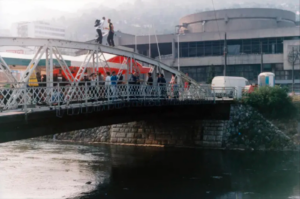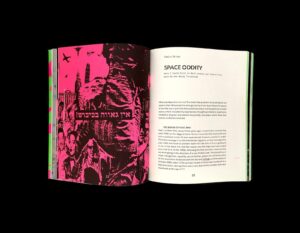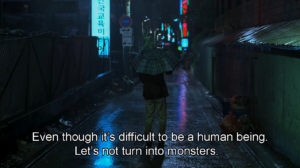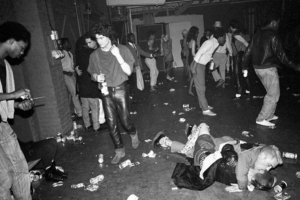humanities, moralities, monstrosities & dancefloors
by Ivan March
where should we go after the last frontiers?
where should the birds fly after the last sky?
Are we human or are we dancer?
Gaza has been torn to the ground. Not the first city to be destroyed due to human violence, and it will not be the last. Rafah seems to be next, while Sudanese, Ukrainian, Russian, Rohingya lives are being extinguished at dystopian rates – some get media attention, others less so – depending on your silobubbletunnel (and who’s bankrolling which content). Meanwhile, our lives go on, we take action on our political concerns however we can, marching, writing, performing, speaking out, hosting the wounded, or we sit doomscrolling with a sideorder of guilt and culpability, or we sit like ostriches in ignorant darkness. We like to think we are free. Yet, Motaz Azaiza reminds us, “don’t call yourself a free people, a free person if you can’t make changes, if you can’t stop a genocide that is still ongoing since the first day. We are so close to being 100 days of murdering and genocide. So, don’t you call yourself a free person if you can’t stop someone to kill someone else. Because, what I witness here is that all the world is ruled by a people that no one in the whole world can say no to them or that they can’t stop them. Nobody shall call themselves a free person if he’s watching another people, another human being getting murdered in front of him, a live show, and he can’t stop this.”¹
So we sit anxiously contemplating our freedoms, and maybe we go for a dance on a Saturday to calm our nerves, feel human closeness and allow some meatgrinder beats to mince our fears. Then perhaps we can face the new day with renewed lifeforce, or just let guilt consume us for seeking pleasure when others hunger and bury their dead. And then we remember, that that is a constant tension in human existence, from time immemorial, it just reaches closer into our homes from time to time.
 mahmoud darwish
mahmoud darwish
Dancing at World’s End
“There was a club, INDUSTRIJA we would go to, where the sirens would run in tandem with the thumping of techno music”, artist and raver Bogomir Doringer reflects on his personal experience during the NATO bombing of Belgrade in 1999.² Rave was a ritual they practised that “deafened the possibility of death at that time; it silenced it, even though it was constantly breathing down (their) necks. At the same time, it was a middle finger to the abusive power of both Miloševic and NATO.” Doringer explores ‘the dances of collective crises’ and his research project ‘Dance of Urgency’ (2019) delves into urgency-driven dance, “it’s dancing as a reaction or a response to the crises of collectives or individuals”. This dance is a primal drive, a form of collective-self-therapy, it is a deep urge where “you need to move to resolve something, such as fear, insecurity, restlessness, possible death, and often you also move to find others like yourself.” A few years prior, while Serbia and Bosnia were at war, Banja Luka DJ, Mladen Tomic, remembers collecting music at the time: “because of the war there were times we’d be without electricity, or we’d have it for just two or three hours during the day so if you missed your radio show, you missed the music.” ³ In Kyiv just a year ago DJs were showing up for gigs in their military uniforms, they’d play for some hours and then return back into combat.⁴
 ravers on a bridge, futura festival bosnia, photo: courtesy of chris korda
ravers on a bridge, futura festival bosnia, photo: courtesy of chris korda
Futura emerged, one of Bosnia’s first major electronic festivals, and Meltdown Mickey, was playing in an abandoned burnt-out youth house, where rock and pop acts used to play before the war. He is an OG member of the UK’s Spiral Tribe free party movement. A movement that mushroomed in the 90s, when new age travellers moved around in graffitied buses crammed with people and giant DIY sound systems. These self-proclaimed ‘tekno tribes’ threw raves in isolated spots – celebrating freedom as a political act. They were united by their love of jungle, techno and hardcore music, and these parties were free of charge and free of rules. They were soon at war with their own government. In 1994, Thatcher issued the Criminal Justice and Public Order Act to crack down on these free spaces, marking them as officially ‘illegal’.
Humans have always disagreed on what is moral, what is right, what can be decreed legal or illegal. Art is a way to take a walk in someone’s shoes, an inter-human metaphysical colonoscopy, a keyhole to see the world as others see it, a gloryhole to secret aspirations, a microphone of mysterious subtexts of our paradoxical subsconsiousnesses. How do you feel in a state of war? Ukrainian sound artist Anna Kravets transports us to an acoustic air raid shelter in ‘An Emotional Encyclopedia of War’. We learn to understand the feeling of threat through self-observations, noises and movements of our fellow human beings – for a moment we are also in an air raid shelter and maybe this could shift our thoughts and feelings about what is right or wrong.
 from adam curtis’ century of the self
from adam curtis’ century of the self
Moralities, Mortalities and Rave-sistance
“our minds are hurt more often by overeating than by hunger.” — Petrarch
Once again we sit facing our screens drowning in information trying to make sense of the world and ourselves in it. In a digitally hyper connected world, ignorance is no longer an excuse when it comes to bigotries, injustices or exploitation, and in a particularly charged era of identity politics, private actions or thoughts often become very public. Scrutiny is sky high, hypocrisy is higher, attention is the new oil, and authenticity seems elusive. Money and power (in the form of fame) further distort the already weakened truth leading us into a confusing post-truth realm.
Scottish philosopher Jonathan Rowson, in his piece ‘Gaza as a Crucible of Perception’, distils the driving mechanisms behind the war in Palestine/Israel in three words: “racism, colonialism, and denial.” ⁵
He aptly references Bayo Akomolafe’s open letter, ‘Dear White People’⁶, which highlights the ethical imperative of our times being “to re-join nature and, in so doing, become indigenous again.” Part of this is interrogating ‘whiteness’ as a default perception:
“An ethico-politico-scientific apparatus produced whiteness, sustained it on the promises of scarce privilege, and cut you off from the abundance of the world around you. The soul of whiteness is the colours it excludes from mattering, the colours and voices that now haunt you from liminal places.”
He also argues, that saying sorry is not enough:
“A deeper sort of accountability is needed – one that brings us to the edges of ourselves. One that helps us notice that we are a palimpsest of colours, and that who or what we are is always in the making. Forgiveness is settling debts; reconciliation is troubling boundaries.”
And this is precisely what rave and art and psychedelics and ancient pagan ceremonies have been all about. Troubling, interrogating and overall fucking with boundaries as a means to continuously evolving our perception of the world.

The stories of Dionysian cults raving on mountaintops into the night, mirror the tales of wild free-spiritedness of Spiral Tribe illegal raves, and all these whispers travelled towards the middle east. Resisting commercial culture and political oppression, one of the very first queer movements to appear in the region, as far as I know, popped up in Tel Aviv in 2001. It was inspired by punk and raves, and envisioned a world of total acceptance, while embodying the concept of Temporary Autonomous Zones (TAZ).
The approach and tactics used by Queerhana evoke the ancient practice of the Carnival. The carnival, as Russian thinker Mikhail Bakhtin described it, carries a particular subversive wisdom which is rooted as far back as in the ancient world. It is a moment in which everything is permitted, a happening on the border between life and art, a form of life shaped by the principles of playfulness, the elimination of any hierarchy and an intense sense of unity. Participants in the carnival feel they are part of an ‘utopian collective body’, where life is lived as festive. It is not to be seen as a hedonist escape from ‘true’ reality – but rather an expression of a more desirable form of being and potential.
Queerhana was born – in a cross-pollination process of western subculture and queer ideas, and the local Middle Eastern cultures and troubled reality. “It opened up a new space with its actions, its territories usually marked by dayglo pink ribbons and parts of broken dolls, within them formed what felt like lasting/temporary alternative free realities. The messages were expressed in the parties in humorous, grotesque manners, through drag, music, video projections and theme parties.
The self-organised approach resonates the ideas of British punk band Crass, who initiated the anarcho/peace-punk movement of the 1980s, with the idea of creating a concrete foundation of independent cultural production and living outside of the capitalist system. They lived together in a commune, printed their own record covers and supported squats and community centers. Their ‘anarchy and peace’ message and practice resonated with our own feelings when starting Queerhana, of rage and a drive to create positive change. The illegal rave scene in the 1990s was a mutation of that peace-punk spirit – the free party scene in the UK, as well as the trance nature parties in Israel, transformed punk’s rage into a pirate party culture. Persecuted consistently by the authorities, who obviously had some intuitive understanding of the rebellious essence of raves.”⁷
It feels that the Queerhana imaginaries are a distant echo, yet what is needed the most right now, alongside cessation of violence, is grieving, union and collective processing of the intergenerational traumas that have erupted all over the globe.

Monster’s Ball
“I want to throw up because we’re supposed to quietly and politely make house in this killing machine and pay taxes to support our own slow murder and I’m amazed we’re not running amok in the streets, and that we can still be capable of gestures of loving after lifetimes of all this.” ― David Wojnarowicz, Close to the Knives: A Memoir of Disintegration
I grew up as a queer kid, to balkan war migrant parents in Athens, Greece. I grew up next to the sea. I was bullied for being a faggot, and then as an adult I bullied myself for being a faggot. The dancefloor has been a place where I found communion and liberation, even just momentarily – but it was enough. If I didn’t find dancefloors in my youth, or didn’t have the internet when I was 11, which allowed me to anonymously talk to other gays, I would have very likely been just another suicide statistic. So, it isn’t a grand surprise that I found immense, life-affirming value (and employment) in music, parties, and spaces for collective self-expression – and I am certainly not pioneering here. But what the notion of chosen family and drag sisters have taught me is that “to be an equal part of society you have to be allowed to speak of shared and divergent perspectives on how we all got here, on our formative influences and experiences, and how that shapes our view of the world, even if they are uncomfortable for others, and perhaps especially because they are uncomfortable for others.” Otherwise, we’re dealing with inauthentic relationships – and ain’t nobody got time for that.

Poets Bseiso and Darwish write:
Can one piss in a tank?
Can he read in the tank?
Can a person fly pigeons in a tank?
Can one fuck in a tank?
Or plant trees in the tank?
…
How long have you been in the claws of the tank?
How long have you been safe?
And when I read it, my history and my lens, replaces the word ‘tank’ with ‘closet’, and the rhetorical answers to the questions remain the same.
I don’t think that any form of fundamentalism belongs on a dancefloor. Whether it is zionism (as a supremacist ideology, that evolves to repressive colonial practice, not a simple proclamation for self-determination), or any type of nationalism, racism, or discriminatory -ism. Other fear-based pathologies such as homophobia, transphobia, sexism, and any racial, gendered, cultural superiorities ought to be left outside the unifying danceable spaces – but we still carry our traumas around with us, so there are no guarantees when it comes to dancefloor politics. I grew up with both blood family and strangers on dancefloors deeming me, and others like me, monsters. But it turns out that lots of people like coming to monsters’ balls, and we simply need to build spaces that will attract those who find belonging there. What we need to do is build structures of care, we need to speak to one another, dance closely with one another, channel radical receptivity side-by-side with radical honesty. We need to cultivate compassion cultures and find a way to tend to our collective wounds while keeping tenderness with the troubled boundaries.
I cannot speak for an entire festival community; we are strong via the tapestry of differences that are woven in together by a common love of sound, the outdoors, and intimate somatic movements, of our love of the night and the day, of colours and textures and experimentations. Words will unite and divide, but what we can hold onto is daydreams of rebuilding ourselves alongside others, around a lake that feels like a collective home.
Perhaps it is quixotic, foolish idealism, but for now, it still seems that we can try to find an allegorical patch of grass and try to vibe with Rumi,
when the soul lies down in that grass,
the world is too full to talk about.
ideas, language, even the phrase each other
doesn’t make any sense.
and maybe it is a pipedream but I still can’t help but want to wake up and see if, along with my chosen family, can make that pipedream come alive.
out beyond ideas of wrongdoing and rightdoing,
there is a field. I’ll meet you there for a last dance.
rêve on.
 bagley’s warehouse, king’s cross, june 1985, dave swindells
bagley’s warehouse, king’s cross, june 1985, dave swindells
References
1. Motaz Azaiza quote
2. Bogomir Doringer ‘the political bearing of the dancefloor’ – Minimal Collective
3. How the 90s Rave Scene Brought War Torn Bosnia Together – Vice
4. Kyiv Ravers escape horrors of war through music – Reuters
5. Gaza as a Crucible of Perception – Jonathan Rowson
6. Dear White People – Bayo Akomolafe
7. Queerhana – Utopia Now! Moshe Kutner